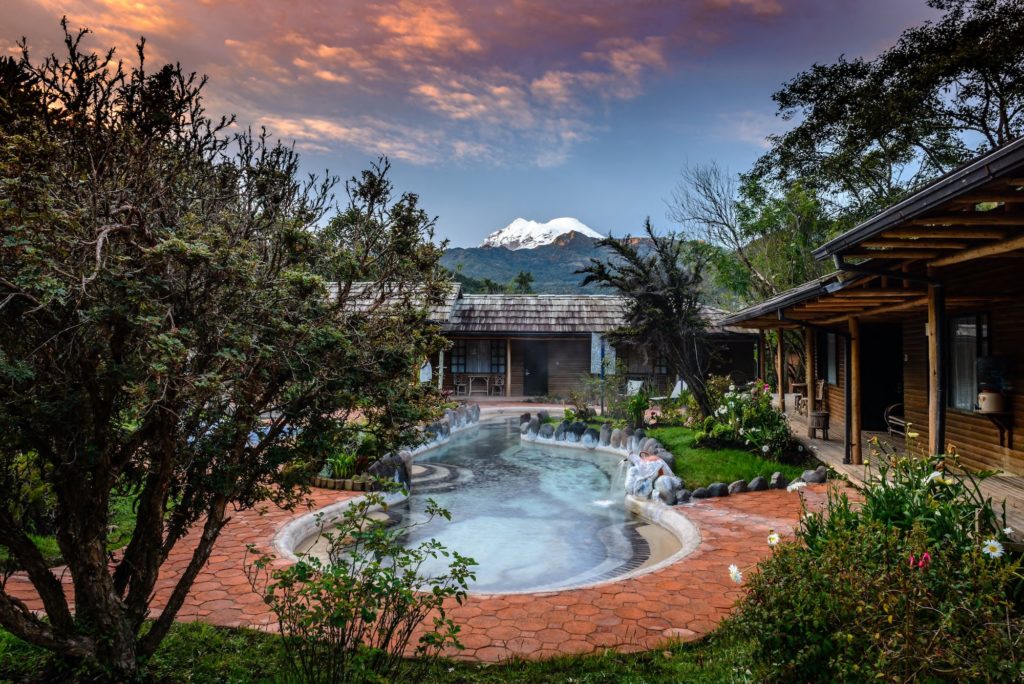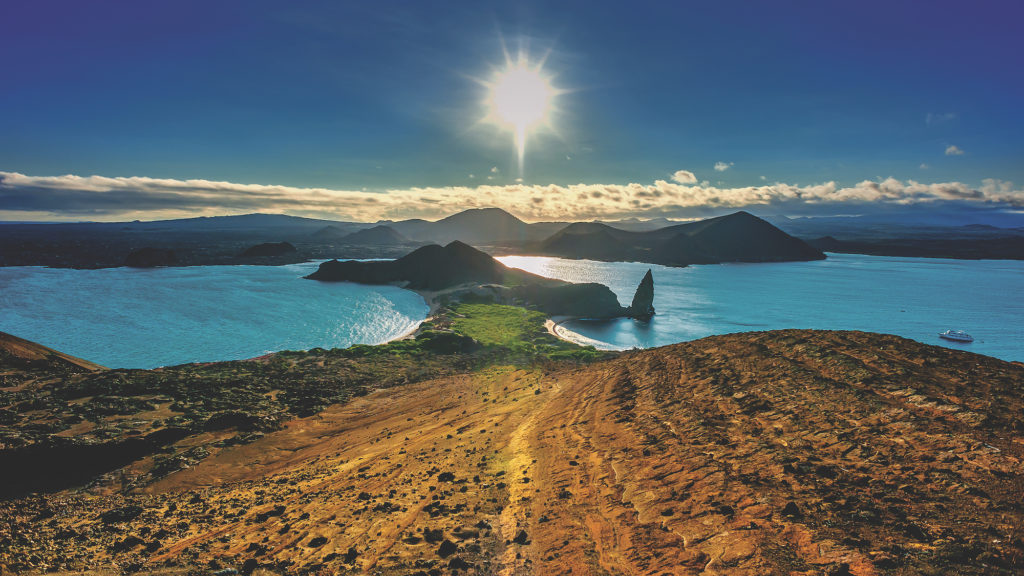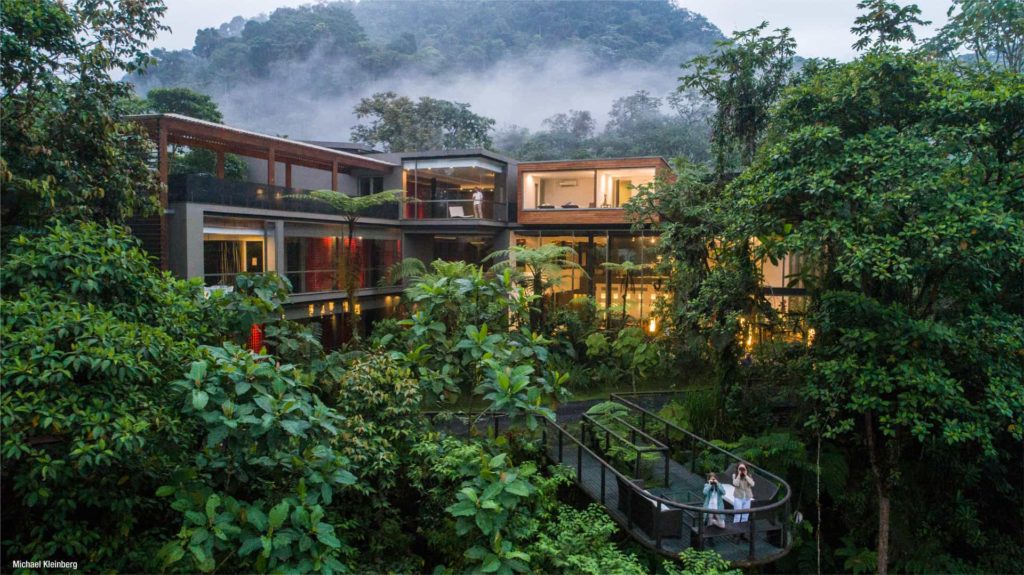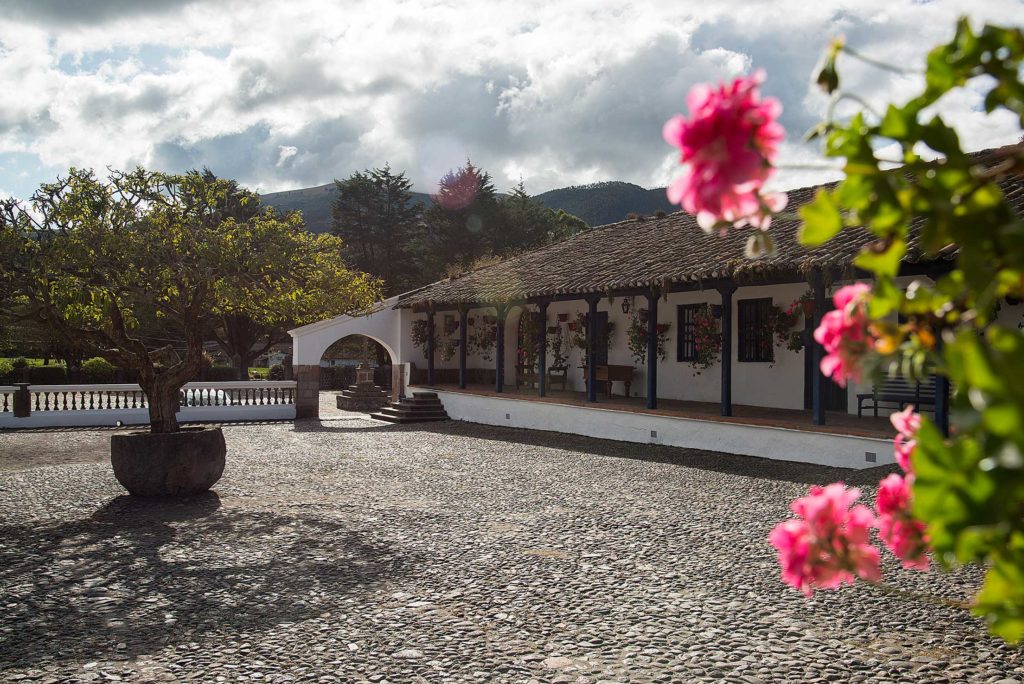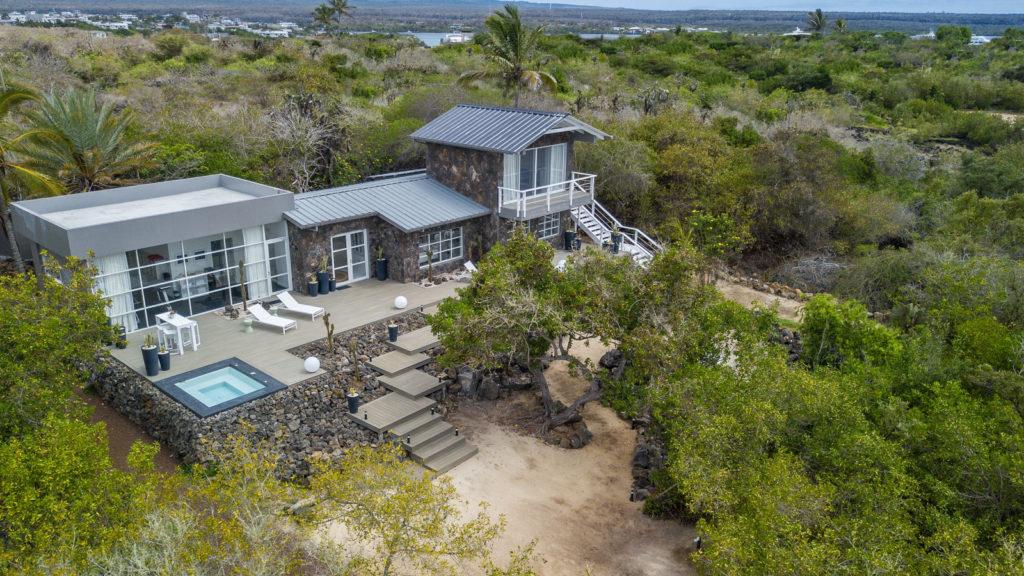For your honeymoon, why not take in the beauty and wonder of Ecuador and the Galapagos? Explore the old towns of Ecuador and take in its history. You will also get the chance to take in the incredible biodiversity of the area from ground level as well as from above when you visit Mashpi. The highlight of the trip is when you explore the Galapagos, with its unique wildlife, flora and fauna. This is the perfect trip for the newly wed couple looking for a unique, special honeymoon.
- Quito
- Mashpi
- Hacienda Zuleta
- Santa Cruz Island
- Papallacta
Quito
Quito, the capital of Ecuador, resides high in the Andes at 2,850m above sea level, astounding visitors with even higher peaks. It is flanked by the impressive Pichincha Volcano, accessible via cable car for a breathtaking view of the city. Quito’s primary attraction is a beautifully preserved historic centre, where grand colonial-era churches and the presidential palace can all be found surrounded by a dozen square blocks of narrow streets and various public squares
Cloud Forest
Ecuador’s cloud forests are found on the slopes coming down from the Andes. With pleasant climates and great biodiversity, orchids, hummingbirds, butterflies and more are all popular highlights for visitors. Local guides are able to point out hundreds of species and the great thing is that it is all found a short drive or hike away from the lodges in this area.
Cayambe
Cayambe is a small town to the north of Ecuador named after the Cayambe volcano, located in the Cayambe Coca Ecological Reserve. The town of 40,000 inhabitants lies at the base of the mighty volcano, which has a height of 5,790 meters above sea level, and is the third-highest of Ecuador’s many Andean peaks. It is just one of the several majestic snow-capped peaks the country has to offer, and is a point of admiration in northern Ecuador!
Imbabura
Imbabura is a province famous for its beautiful collection of lakes and lagoons which has earned it the nickname “Land of the Lakes”. More than lakes are valleys, volcanoes, and wild barrens. Each town and village is totally diverse and proudly boasts traditional cultures and practices unlike anywhere else in Ecuador. The Imbabura Volcano, peaking at 4,600 meters above sea level, is an awe-striking site when passing through San Pablo as the volcano seems to tower impressively over the San Pablo lake and its surroundings.
Galapagos Islands
The legendary Galapagos Islands are Ecuador’s main attraction, accessible only via direct flights from two mainland cities. This vast archipelago of volcanic origin is home to abundant wildlife on land, in the air and underwater — all carefully protected to showcase “time capsule” ecosystems, just as they were thousands of years ago! Giant tortoises, playful sea lions, blue-footed birds, turtles, penguins, flamingos and iguanas are just some of the memorable highlights.
Papallacta
Papallacta is located in the Andes not far from Quito in the Cayambe-Coca Reserve, it is famously known for its thermal hot springs. With its location still high in the mountains, the weather can be cold, drizzly, and even misty, however this only increases its appeal. The nearby volcano of Antisana and the volcanic complex of over 3 million years called Chacana is what continues to feed the thermals after all this time.
You will have a private transfer from the airport to your selected hotel in Quito. Look for a sign with your name on it when arriving. The airport is located in the town of Tababela, about 43 km from Quito and it will take approximately 45 minutes to one hour to arrive.
Pacari Awarded Chocolate Box
Delight your senses with this exclusive chocolate arranged for you as a welcome gift to Ecuador. This wooden box contains a variety of forty different mini-bars of Pacari’s best chocolate with a detailed presentation of this selection and its award-winning flavors.
Today you will take part in a tour of Quito’s old town and many of its most famous attractions.
Tour of Quito
During the historical city tour of Quito, you will explore the best preserved colonial centre of all of South America. As one of the first World Heritage Sites, it will be an unforgettable experience as if you were stepping back in time.
The first stop is the Basilica del Voto Nacional. Due to its size and style, it is considered the largest neo-Gothic temple in the Americas, and the most important piece of neo-gothic architecture in Ecuador. You will continue to the Plaza Grande, or Independence Square. Admire the historical buildings surrounding the square and it’s important history! Located here is the Presidential Palace, the Catholic Cathedral, and the Archbishop’s Palace.
Another visit you will enjoy is the most impressive of all churches, the San Francisco de Quito. The church houses masterpieces of talented indigenous artists from the famous methods of Escuela Quiteña, “Quito School”, which are the artistic traditions associated with the 17th and 18th centuries. Walk through the lively colonial streets of the old town to visit other historical highlights such as the Panecillo, from where you will have an amazing 360 degree view over the city.
The second part of this tour will take place at the north part of the city (35 minutes’ drive from Quito’s Old Town) where the equator line meets the prime meridian and the coordinates indicate point 0° 0’ 0”.
La Compañia Church
One of the highlights of the city tour is the visit to La Compañia Church, considered to be a Baroque masterpiece. The facade is made of volcanic stone and the interior is all covered with gold.
Middle of the World Monument
A must-see stop during your visit in Ecuador is the Middle of the World. Here an Equator Monument was built to honour the 18th century French Geodesic Mission, led by French scientists Condamine, Bouguer, Godin and the Ecuadorian geographer, Pedro Vicente Maldonado, who studied the curvature of the planet and who determined the supposed location of the equator. This unique place allows you to be a part of a historic landmark in what was once thought as the exact equator line, and of course you can’t miss taking your picture with the monument in the background with one foot in each hemisphere!Additionally the complex offers an Ethnographic museum, a planetarium, artisanal stores great for picking up souvenirs, coffee shops, and restaurants that serve local food.
Intiñan Museum
The Intiñan Museum is a smaller, but highly interactive museum located right next to the Mitad del Mundo Monument. Even though the monument features the division of the equator, when technology improved, geologists and cartographers realised the real equator line was just a bit off. It features outdoor exhibits of astronomical geography and explanations of the importance of Ecuador’s geographical location. One of the highlights are the solar dials, fun experiments that can only be done here, like balancing an egg on a nail, and many more activities, as well as reconstructed native homes found all over Ecuador.
Day 3 begins with the journey from Quito to Mashpi. It is the first in a three day tour of Mashpi and its surrounding area.
Mashpi – Tulip Ruins
Mashpi Lodge is located about 3 hours travelling to the northwest of Quito via the western flanks of the Andes. It blends in perfectly in the surrounding Ecuadorian Choco cloud forest with a modern, luxurious design and decor and it is where you will be staying for the next two nights.
The Ecuadorian or Andean Choco cloud forest is known for being one of the world’s best sites for bird-watching, just a few years ago it was named as a Biosphere Reserve by UNESCO. There are many endemic plant and wildlife species here, meaning they cannot be found anywhere else in the world other than this specific micro-climate in the Andean Choco cloud forest. Once you arrive in Mashpi, you will plan your activities with the Mashpi team and receive a briefing on the lodge, accommodations, and how the activities will operate during your time in the cloud forest.
On your way to Mashpi Lodge, you will visit the archaeological ruins at Tulipe, said to have belonged to the ancient Yumbo civilisation of pre-Inca Quito, set in a magical forested location. You will taste delicious Ecuadorian appetisers and fresh-brewed coffee prepared by members of the local community before your final one-hour descent into Mashpi Lodge. You will be introduced to your naturalist guide who will briefly speak about the cloud forest and the activities offered during your stay, as well as helpful tips about what to wear and bring during the excursions. Afterwards you have time for lunch before the afternoon activities, which may include a hike through the forest or an opportunity to see the forest from above on Mashpi’s Dragonfly aerial cable car.
In the evening, your guide may ask you if you’d like to go out and search for wildlife on a night walk. When the sun sets in the Choco cloud forest, all sorts of different life forms come to life such as frogs, snakes, insects, and even tarantulas. Your guide will know how to find them and show you the best way to experience these incredible creatures.
Dragonfly Experience
The highlight of any trip to Mashpi is the Dragonfly – an exciting, open-air cable car system that carries you over, across and sometimes even directly through the forest canopy, offering guests a relaxing way to enjoy the reserve from overhead. The guides can stop the gondola you ride across the forest at any point to allow for an extended observation of any flora and/or fauna that catches your eye. An entire circuit (round trip) takes about 40-minutes to complete. Gondolas can carry up to 4 guests (plus 1 guide).
After staying the night in Mashpi Lodge Spa, you will then take part in the second day of your tour of Mashpi.
On this day you may be awakened by the mixture of bird activity, as you know, the early bird gets the worm. After breakfast your guide may invite you for a walk to a waterfall where you can bathe in the pools with the water crashing behind you, or maybe your guide will suggest visiting the hummingbird garden, or the life centre’s butterfly farm. Here you can explore the life of butterflies, the many species found in the Mashpi area and their metamorphosis from egg, larva, caterpillar, and chrysalis to winged wonder. The guides will also discover various species of host plants that butterflies use to lay their eggs on, such as passion flowers, birds of paradise, milkweeds.
Optional Activities
Afterwards, you’ll be back for a delicious lunch where your guide will explain further the other exciting and interesting activities available at Mashpi. You might have the opportunity to pedal on the sky bike above ground and through the canopy like one of the many birds found in the Choco Forest. Mashpi guides are keen on noticing every sound and rustle in the leaves, hoping to reveal colorful birds, while explaining the habitat’s ecology. Another activity available is to climb up to the observation tower to view much of the Choco cloud forest from above with a bird’s eye view and watch the sunset as it descends slowly. In the evening, the guides and staff like to prepare different and engaging lectures on the diverse wildlife and plant life, or the scientific research projects conducted in the same Choco Forest you’ve been discovering.
For your final day in Mashpi you have time to fill in as you wish. You can let your guide know if you are interested in additional activities before heading back to Quito. You might be able to visit a waterfall or special place in the forest to soak it all in one last time. Check out will be at about 11:00 am and you will be transported back to Quito to your hotel.
Dinner at Theatrum Restaurant
Located in Quito´s Historical Centre on the second floor of the Sucre National Theater, the oldest theater built in Quito in the 1880’s and an important cultural building, you will find the Theatrum Restaurant & Wine Bar; a perfect setting for top-class theatre performances, from dance to musical concerts.
Here, you will enjoy a five-course tasting menu, composed of spectacular traditional Ecuadorian-Mediterranean cuisine created by some of the most talented chefs in the country.
Compania de Jesus Hacienda and Rose Plantation
Ecuador is the third largest exporter of roses in the world. They are much more appealing compared to roses from other locations due to their size, longevity, and variation of over 500 colours, thanks to the special micro climate conditions of Ecuador, especially along the equator.
You will visit the hacienda “La Compañia de Jesus”. It originally belonged to the Jesuit Order when they established themselves in Ecuador about 300 years ago. What was once a barn for the Jesuits to keep them safe and in hiding, has been transformed into a unique rose museum with an exquisite permanent exhibition showing more than 5,000 different stems of the most colourful varieties of roses grown at the plantation. You will be able to discover this interesting and colourful showroom while enjoying a typical refreshment known to the region.
Otavalo and Surroundings
You will first visit the town of Otavalo, famous for its indigenous market that is held every day, with the largest bargains and traders present on Saturdays. The market is an ancient tradition and cultural exchange site among the Otavalo community. Furthermore, you can visit the peaceful town of Cotacachi, famous for its leather products such as shoes, purses, coats and belts. You can browse the products and meet the local craftsmen who create these beautiful pieces.
Hacienda Zuleta
You arrive at Zuleta in the afternoon after a drive through lush pasture lands. With some luck you will have stunning views of the snow-capped volcano, Cayambe, which is just a few miles away from Zuleta. A host will welcome you personally upon arrival, and assist you with check in to your guest suite. Once settled, one of the family owners or managers will personally tell you about the activities the hacienda offers and find out about your personal preferences, needs or questions over tea or coffee.
After planning your stay, you will be shown around the main building. You will learn more about Zuleta’s history, see ex-President Galo Plaza Lasso’s private library, our chapel and wander through our beautiful gardens. As the sun sets, it gets chilly at Zuleta, so enjoy some wine and our farm made cheese in front of the fireplace while reading from our vast libraries prior to dinner.
There are a number of activities you can enjoy during your two-night stay which are listed in the additional information section.
Luxury Picnic
You will end Day 7 with a picnic. You can enjoy an exclusive meal in the fresh Andean air and stupendous scenery in the hacienda’s tranquil picnic area, surrounded by Caranqui mounds and towering mountains. You will be served by your own personal chef and delight in an array of flavors with a delicious traditional meal.
A free day for travelling. You will spend the night at EB Quito Hotel.
You will have a private transfer from your selected hotel to the Quito airport and then fly to Baltra airport on Santa Cruz Island.
Day 9 is the first of a four-day program through the island.
Flight to Galapagos and Highlands Excursion
In the continental airport you will have to pay $20 in cash per person for the INGALA card, also known as the Transit Control Card. This is a migratory card that you will need to enter the Galapagos Islands and present when arriving to immigration. You will also need this card upon leaving the islands. Keep it in a safe and secure place during your time in the Galapagos Islands. Additionally, while at the continental airport before leaving, you will pass your luggage through a screening process to make sure no invasive plants or animals will enter the Galapagos Islands.
After lunch, you will go to the highlands of Santa Cruz Island, up to a private farm where you will enjoy your first visit to the Galapagos Islands. Your guide will take you for a nice walk among the beautiful trees of the forest including ferns and sedges, miconias, etc. Here you will be amazed with the giant tortoises that roam freely in the farm, their natural habitat. It is very important not to bother, touch or feed these beautiful animals. The area also contains several species of birds including the famous Darwin finches, the rare “Pájaro Brujo” (Wizard Bird) with it’s beautiful red coloration, and many more. At this place you also find a simple but nice structure where you can rest and buy drinks, beers or a try delicious local fruit juices and snacks. Later on you’ll head to one of the many lava tunnels existing in the area. Here you enjoy of a short hike into the tunnel, where one can admire the amazing results of powerful volcanic eruptions occurred some 5 million years ago that shaped the islands we know now.
You will then stay the night at Finch Bay Hotel.
During the following two days in the Galapagos (Day 10 and Day 11), you can choose one land based activity and one navigable activity each day. The activities will be booked according to their availability. The list of these tours can be found in the additional information section.
Today you will fly from Baltra Island to Quito. The air ticket is sold separately. You will have a private transfer to your hotel in Papallacta. The airport is located in the town of Tababela, about 43 km from Quito and it will take approximately 45 minutes to one hour to arrive.
Papallacta Hot Spring
You will visit the Termas de Papallacta, located in the area where the Andes begin to transform into the cloud forest and shortly after into the Amazon. It is a place where the beauty of the natural environment combines with unique and cozy atmospheres. This will be a special stay designed with you in mind in order to enjoy unforgettable moments as a romantic getaway.
Private transfer from Papallacta to Quito Airport. From here you will take your departure flight home.
Dates are flexible so please make an enquiry and tell us a range of dates you are considering so we can check availability.
Activities at Hacienda Zuleta:
Condor Huasi Project:
The “Condor Huasi Project” is highly recommended. In the mornings, you are more likely to see wild Condors soaring as the sunlight creates thermal up drafts. The Condor project is located in a native forest valley, and accessible via vehicle, horseback or on foot. You will learn about the foundation’s efforts, see rescued condors in the aviary, and perhaps visit the nearby trout farm.
Gardens:
If you enjoy early mornings, you might want to take a short walk around the property prior to breakfast taking in the beautiful scenery and fresh Andean air. There is an abundant variety of bird life attracted to the Zuleta gardens.
Hiking and Trekking:
You can also decide to give yourself a challenge and hike up to the Condor viewpoint, which provides a great panoramic view over the Zuleta Valley. Sightings of the Andean spectacled bear are common in this area.
Caranqui ruins:
Through the pasture lands of Zuleta you can discover ancient mound sites from the times of the Caranqui people; these mounds date back to 700 C.E. and constructed these large mounds in the earth and raised fields for their use before the Incas arrived from the South.
Milking cows:
There is always something to see and do on the hacienda, adjacent to the main courtyard, the milking barn is full of activity at daybreak, as some of the more than 300 Holstein dairy cows are being milked by the Hacienda staff. Zuleta Hacienda was actually the first to bring Holstein dairy cows to Ecuador by ex-President Lasso.
Cheese Factory:
Staff at the hacienda will suggest a guided visit to the cheese factory in order to learn more about Zuleta´s semi-aged handmade cheeses, how the process has changed throughout history, and where the cheeses are sold, both domestically and internationally.
Zuleta Embroidery Project:
It is always possible to visit the Zuleta Embroidery project and workshop. Here you can meet with members of the Zuleta community, for these locals hand embroidery has been an important part of artistic and cultural expression for centuries. The project aims to keep this art form alive and well in the community through educational components and in providing the local people with a sustainable form of income through their own embroidery shop.
Agricultural activity:
You are invited to explore Hacienda Zuleta’s organic garden, you can learn about permaculture and see where the produce and ingredients for your meals originated.You can explore the farm operations, feed calves, count sheep, talk to the vaqueros (local cowboys), enjoy the embroidery museum, or relax in the garden.
Included visits and activities:
Condor Huasi Project, gardens and lagoon, chapel, 60 km of self-guided trails and 1,700 hectares of protected land, cheese factory, orchards, permaculture sustainable methods, milking experiences and foundation projects such as the community library and store with hand-embroidered products.
Additional services not included in the rate:
Alcoholic drinks, Horseback riding or cart rides, Embroidery or cooking classes, Bikes, Specialised Bilingual Guide Service (Naturalist, bird handler, equestrian), Massages, Manual milking, Transport service to move inside and outside the Hacienda, Laundry services.
Santa Cruz Islands – Navigable Tours
Guided Highlands and Giant tortoises visit with lunch
You will depart your hotel to the Highlands of Santa Cruz. From there a short drive across the farming areas will lead you to the El Manzanillo Ranch at the northern edge of the Giant Tortoise Reserve. El Manzanillo is located on the natural path tortoises take every year as they either migrate from higher moist locations during the garúa season (June-September), or when they descend to the warmer lowlands during the wet season, as well as their paths during their breeding seasons. The Galapagos Giant Tortoise is the largest living tortoise species, they can weigh up to 250 kg (550 lb). They play an important biological role as the top grazer in its habitat. In the wild, these gentle giants slowly barrel their way through the plant cover. The shape of their shells varies from island to island, as each had to adapt to the different vegetation on each island. These tortoises are a great example of the theory of evolution. On Santa Cruz, year round, tortoises can be seen grazing on the surrounding vegetation, wallowing in muddy banks or in small ponds cooling off and protecting their skin.
You will see the area is teeming with wildlife with chirping warblers, mockingbirds and flycatchers, as well as ducks and herons, making this an exciting morning visit. On the return to Puerto Ayora, you will also visit one of the island’s lava tunnels, significant geological formations that take you back in time allowing you to see how lava flows formed the islands. Lunch at El Manzanillo.
Tortuga Bay and Charles Darwin Research Station with lunch (guided)
Tortuga Bay is located to the southwest of Puerto Ayora, on Santa Cruz Island. Its name means “turtle”, and the island received this moniker because it is sea turtles favourite place to lay their eggs. The stunning white sand beach is considered by many the most beautiful in the Galapagos archipelago. The beach is reached via a marked and cobbled two kilometre path that starts at the west end of Charles Binford Street; guests must sign in and out at the National Park control point at the beginning of the path– it is open from 6:00 AM to 6:30 PM daily. There is excellent bird-watching along the path, with plenty of Darwin’s finches and other sea birds. And for active visitors, it is a great place to kayak, snorkel and surf!
The Charles Darwin Research Station, which was founded in 1959, is a Natural History Interpretation Centre and carries out educational projects in support of the Galapagos National Park. The Park has the following development programs: Conservation of natural resources, management of flora and fauna, and sustainable use of resources, among others. Their aim is to conserve this natural ecosystem and allow tourists to appreciate all these unique species. Walking around the station you can see many different examples of their work, interesting information and history on the wildlife found in the Galapagos, as well as the human history of the park. You will also have the opportunity to see various wildlife such as Giant Tortoises from other islands, various iguanas, and of course the many birds and finches that fly by.
Santa Cruz Islands – Navigable Tours
North Seymour
North Seymour is one of the best visitor sites to view colonies of Blue-footed Boobies and one of the largest colonies of Great Frigatebirds. The main trail on the island allows you to walk through the nesting areas of these birds; the boobies nesting on the ground and the frigatebirds in the trees of the Palo Santo forest spread out near the trail. During mating season you may see the boobies performing their dance rituals, while the male Magnificent Frigatebirds are puffing out their red chest. The trail also passes by a beach where you may be able to spot sea lions and marine iguanas. Snorkeling is an activity where you can see a wide-array of tropical fish, Whitetip Reef Sharks, Hammerhead Sharks, Parrotfish and more.
Bartolome
At Bartolome, this fantastic visitor site will allow you to see spectacular volcanic landscapes and experience excellent snorkelling. Along the ride en route to Bartolome, you may see dolphins, manta rays jumping in the distance, and even sea turtles. Bartolome Island is famous for Pinnacle Rock, a tuft cone eroded over time creating an amazing site with the blue waters of Sullivan Bay in the background. It is one of the most photographed visitor sites in the Galapagos Islands. At the site, you can walk up the steps of the boardwalk on Bartolome Island to the lookout point for a gorgeous 360 degree view. Afterwards, you will be able to enjoy a panga ride, also known as the zodiacs used to go back and forth from the yacht and visitor sites, where you can get a closer view of the coastline and possible wildlife.
South Plaza
Plazas Island is located to the east of Santa Cruz. South Plazas is the result of two small islets which were uplifted a short distance from the East Coast of Santa Cruz. The unusual vegetation and location of the island create an interesting landscape in which the fauna and flora of Galápagos are enhanced. Moreover, despite its small size, some of the most interesting and outstanding species of the archipelago live here. It is possible to observe land iguanas that are often in the shade of a cactus. Nesting on the rugged southern cliffs, you can usually find swallow-tailed gulls, along with other various sea birds such as red-billed tropicbirds, frigatebirds, pelicans, and blue-footed boobies. The protected rocky seashore is a prime habitat for a large colony of noisy sea lions.
Santa Fe
Santa Fe Island is located southeast of Santa Cruz. The island was formed from an ocean floor uplift and not a volcanic eruption, and therefore, giving it its mostly flat shape.The small bay on Barrington’s northeastern coast is extremely picturesque. One trail leads to a scenic viewpoint on top of a cliff where it is possible to find the Santa Fe land iguana, endemic to the island.The other trail is near the beach and is a short circular trail where it is possible to find another colony of land iguanas. A particular attraction is the unusually tall forest of prickly cactus. Here you will also have the opportunity to kayak, snorkel, enjoy a panga ride and walks to observe and enjoy nature.
- Accommodation based on double room.
- Transportation on the days mentioned.
- English-speaking driver/ guide or driver + guide on the days mentioned.
- Excursions and visits as mentioned in the program.
- Meals mentioned in the program.
- Entrances fees mentioned in the program.
- AIG Insurance (liability insurance).
- Excursions not mentioned in the program.
- Meals not mentioned in the program.
- Drinks, tips and personal expenses.
- All Flights
- Travel Insurance.



